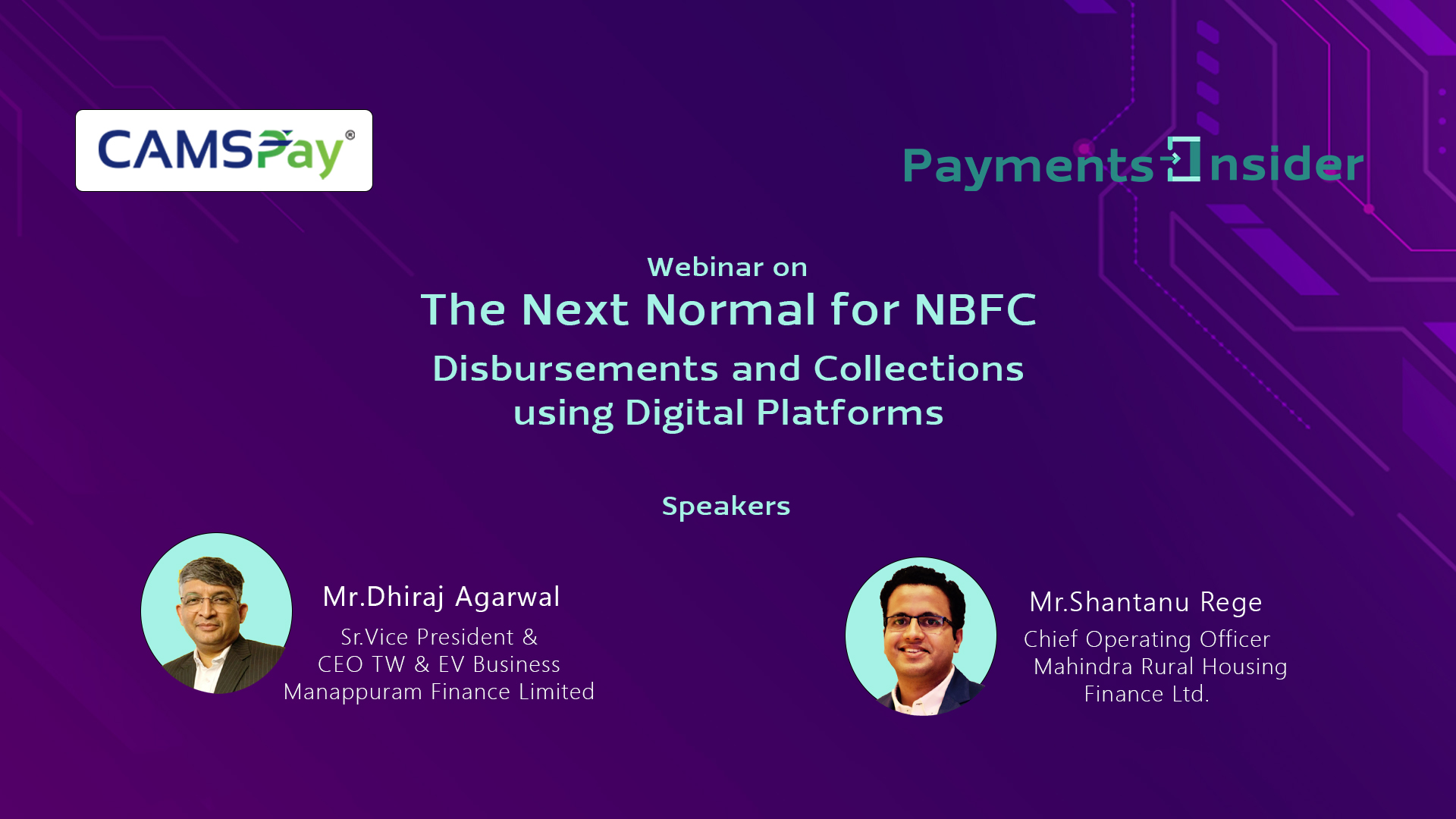As part of CAMSPay’ s Payments Insider webinar series, our latest broadcast discussed how digital payments impact NBFCs disbursement and collection methods.
Our panel included:
Guest Speaker: Dhiraj Agarwal, Senior Vice President and CEO of Two-wheeler and Electric Vehicles business at Manappuram Finance Limited
Guest Speaker: Shantanu Rege, COO of Mahindra Housing Finance Limited
Moderator: Ravi Kiran, Head of New Business, Computer Age Management Services Ltd.

Our panelists discussed a varied range of subjects including:
What are disbursements and collections?
The act of disbursing money, which can include money paid out for a loan, to run a business, or as dividend payments, is known as disbursement. Whereas, the process of collecting debts owed by companies or individuals is known as debt collection.
Dhiraj Agarwal, the first speaker, began by offering his thoughts on current trends in vehicle loan/EMI disbursements and collection methods. He also explained what we can expect in the future with the assimilation of AI and machine learning.
Dhiraj went on to explain how phygital is transforming their day-to-day operations @Manappuram. Adapting to phygital methods, he claimed, not only has improved the client experience but also cut the firm’s overall personnel expense.
“I can present 20,000 checks or 50,000 checks that will helps us to grow and reduces our cost as well.”
He provided a quick overview of how his two customer segments have responded to the new digital collection methods. The electric vehicles segment appears to be resistant to technology, making collection even more difficult in these recent times. Owners of two-wheelers, on the other hand, have a good understanding of technology and are even tech-savvy. Eventually, this enables the firm to do the NACH, eNACH and mNACH authorization and digital collection with complete security and in peace.
“Thanks to today’s digital support that even if the customer gives me a fraudulent PAN, we can determine if it is correct or not in 3-4 seconds.”
He also explained how, with consent, various customer attributes are used to mitigate credit and operational risks. He further said that all modern-day tech-based risk mitigants are carried out only with the customer’s prior consent.
Finally, by affirming that Indian NBFCs have barely scratched the surface of digital capabilities, he expressed his belief that mobile wallets will be the future of digital payment.
“As per my understanding, digital payment will grow at a rapid pace over the next few years, and it may account for 3/4ths of the total payments in India by 2025.”
Following Dhiraj’s straight-forward views about the vehicle loan scenario, our second guest speaker, Shantanu Rege, had some unique insights to give about the house loan business in the country.
Shantanu began by providing a brief overview of how customer segments and loan products differed across traditional banks and traditional NBFCs and how disbursements and collections processes are being enabled in the current lending tech environment.
He also explained how regulations have rightly emphasized the need for systemic risk management and safeguarding consumer rights and convenience.
| Consumer rights and convenience Fair Practice Code KYC guidelines Ombudsman for NBFCs Covid-19 relief measure |
| Systemic risk management Harmonization of HFC and NBFC regulations Risk Based Internal Audit Declaration of dividends – Capital Adequacy and Net NPA requirement Liquidity Risk Management Framework |
“There is an increasing focus on the Regulator’s part to harmonise regulations between Banks- at par with large NBFCs”
When asked about the influence of covid-19 on rural home loan patterns, Shantanu compared both first and the second wave. He affirmed that the first wave had no significant impact on their business. Because the virus was more prevalent in the urban areas. However, this was not the case with the second wave, the second wave had a deep rural impact. For some time, as a safety net, rural loan borrowers preferred to retain cash on hand rather than repay their loans.
“As things are returning to normalcy, we expect that the consumers will become more confident in their repayment ability”
He went on to say that, while they can’t go totally digital like in urban India, Mahindra Rural Housing is gradually moving toward UPI and other payment choices. This is to streamline the overall collecting process and prepare for a third wave or other similar unpleasant circumstances.
“About 60% of our rural customers are cautious about their money being taken away digitally without their knowledge”
He concluded that, while digital payments like UPI and NACH/e-NACH are a viable option for a progressive rural customer, assisted digital payments are where there is a human interface are likely to be more successful especially in the rural context.
Finally, both guests discussed their experiences working with CAMSPay. Dhiraj passionately shared his happiness and faith in the future of the association as their transition to digital payments becomes more widespread.
we people feel the cams like if we find something difficulty, they used to get it resolved and your E notch and your m match and then facility which we are using it find there is always a niche different with others, your competitors.
“We feel whenever we find payment related difficulties, CAMS can resolve them with eNACH and mNACH facilities. They are always ahead of their competitors.”
Shantanu emphasized how CAMS is always one step ahead of the competition when it comes to innovation, and how their partnership with CAMSPay is something to be proud of.
“Our motivation to work with CAMSPay started when we really wanted to push the boundaries in terms of discovering technologies and partners with whom we’ve worked who can help us collect when we couldn’t go out physically.”
Watch the full video to know more about
My brother recomended I might like thiis website.
He wass entirely right. Thhis pot trly mde myy day.
You cann’t imagine simply hoow mch time I hadd spent
for this information! Thanks!